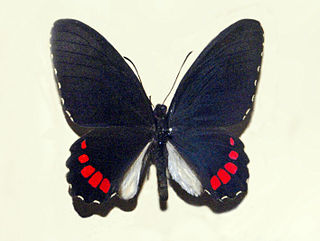
Parides erithalion, the variable cattleheart, is a North and South American butterfly in the family Papilionidae. The species was first described by Jean Baptiste Boisduval in 1836.

Papilio nireus, the green-banded swallowtail, narrow-banded blue swallowtail, or African blue-banded swallowtail, is a butterfly of the family Papilionidae. It is found in Sub-Saharan Africa.
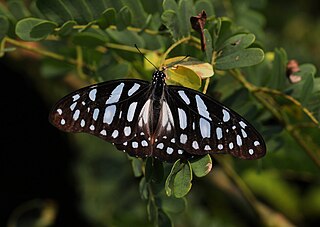
Graphium leonidas, the veined swordtail, veined swallowtail or common graphium, is a species of butterfly in the family Papilionidae, found in Sub-Saharan Africa.

Papilio scamander, the Scamander swallowtail, is a butterfly of the family Papilionidae. It is found from eastern and south-eastern Brazil south into Argentina.

Papilio torquatus, the torquatus swallowtail, is a swallowtail butterfly in the subfamily Papilioninae. It is found from northern Argentina to Mexico.

Mimoides ariarathes is a species of butterfly in the family Papilionidae. It is native to South America.

Mimoides phaon, the red-sided swallowtail or variable swallowtail, is a species of butterfly in the family Papilionidae. It is native to the Americas.
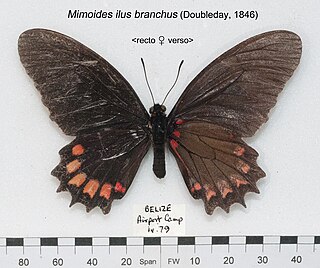
Mimoides ilus, the Ilus swallowtail or dual-spotted swallowtail, is a species of butterfly in the family Papilionidae. It is found from Mexico to Colombia and Venezuela. Little is known about this rare butterfly, but it is not considered threatened. The larvae of M. i. branchus feed on Annotata reticulata.
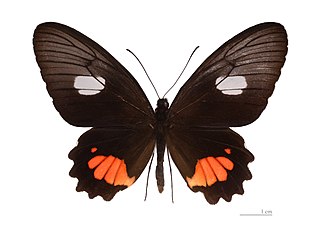
Parides anchises, the Anchises cattleheart, is a species of butterfly in the family Papilionidae native to the Americas. It is common and not threatened. The larvae feed on Aristolochia species including: A. brazilsis, A. bukuti, A. colombiana, A. cymbifera, A. fimbriata, A. inflata, A. macroura, A. odora, A. ringens, and A. triangularis.

Battus belus, the Belus swallowtail is a species of butterfly from the family Papilionidae that is found in Brazil, Colombia, Guatemala, Peru and Venezuela.

Parides bunichus is a butterfly of the family Papilionidae. It is found in Brazil, Paraguay, Argentina and Uruguay.

Mimoides xeniades is a butterfly in the family Papilionidae. It is found in southern Bolivia, Ecuador, Colombia and Peru.

Parides echemon is a species of butterfly in the family Papilionidae. It is found in the Neotropical realm.
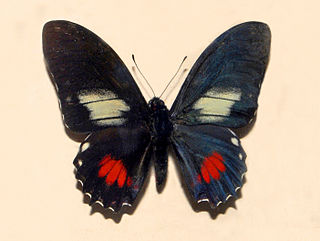
Mimoides euryleon, the false cattleheart swallowtail, is a species of butterfly in the family Papilionidae.

Mimoides pausanias, the Pausanias swallowtail or bluish mimic-swallowtail, is a species of butterfly in the family Papilionidae.

Mimoides protodamas is a species of butterfly in the family Papilionidae. The common name is false polysticto, with reference to the similarity of this species with Battus polystictus.
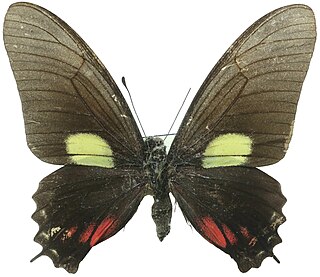
Mimoides xynias is a species of butterfly in the family Papilionidae. It is found in the Neotropical realm.
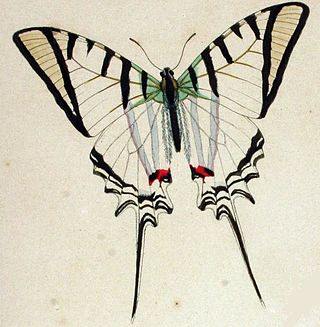
Protesilaus protesilaus is a species of butterfly of the family Papilionidae. It is found in the Neotropical realm.

Protesilaus helios is a species of butterfly of the family Papilionidae. It is found in the Neotropical realm.
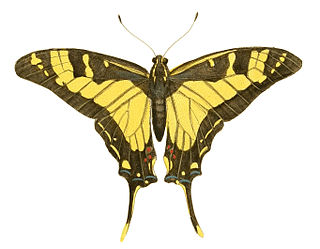
Eurytides thyastes is a species of butterfly found in the Neotropical realm.





















